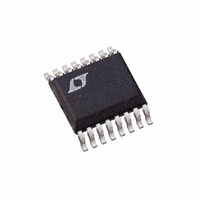LTC3717EGN#TR Linear Technology, LTC3717EGN#TR Datasheet - Page 13

LTC3717EGN#TR
Manufacturer Part Number
LTC3717EGN#TR
Description
IC STEP-DWN CONTRLR SYNC 16-SSOP
Manufacturer
Linear Technology
Datasheet
1.LTC3717EGN.pdf
(20 pages)
Specifications of LTC3717EGN#TR
Applications
Controller, DDR, QDR
Voltage - Input
4 ~ 36 V
Number Of Outputs
1
Voltage - Output
2 ~ 18 V
Operating Temperature
-40°C ~ 85°C
Mounting Type
Surface Mount
Package / Case
16-SSOP
Lead Free Status / RoHS Status
Contains lead / RoHS non-compliant
Other names
LTC3717EGNTR
Available stocks
Company
Part Number
Manufacturer
Quantity
Price
APPLICATIO S I FOR ATIO
When the voltage on RUN/SS reaches 1.5V, the LTC3717
begins operating with a clamp on I
0.9V. As the RUN/SS voltage rises to 3V, the clamp on I
is raised until its full 2.4V range is available. This takes an
additional 1.3s/ F. The pin can be driven from logic as
shown in Figure 5. Diode D1 reduces the start delay while
allowing C
tion.
After the controller has been started and given adequate
time to charge up the output capacitor, C
short-circuit timer. After the RUN/SS pin charges above
4V, if the output voltage falls below 75% of its regulated
value, then a short-circuit fault is assumed. A 1.8 A cur-
rent then begins discharging C
persists until the RUN/SS pin drops to 3.5V, then the con-
troller turns off both power MOSFETs, shutting down the
converter permanently. The RUN/SS pin must be actively
pulled down to ground in order to restart operation.
The overcurrent protection timer requires that the soft-
start timing capacitor C
antee that the output is in regulation by the time C
reached the 4V threshold. In general, this will depend upon
the size of the output capacitance, output voltage and load
current characteristic. A minimum soft-start capacitor can
be estimated from:
Generally 0.1 F is more than sufficient.
Overcurrent latchoff operation is not always needed or
desired. The feature can be overridden by adding a pull-
up current greater than 5 A to the RUN/SS pin. The
additional current prevents the discharge of C
fault and also shortens the soft-start period. Using a
resistor to V
increases shutdown current. Connecting a resistor to
INTV
shutdown current, but requires a diode to isolate C
pull-up network must be able to pull RUN/SS above the
4.5V maximum threshold that arms the latchoff circuit
and overcome the 4 A maximum discharge current.
C
SS
CC
> C
as shown in Figure 5b eliminates the additional
OUT
SS
IN
to charge up slowly for the soft-start func-
as shown in Figure 5a is simple, but slightly
V
OUT
U
R
SENSE
SS
U
be made large enough to guar-
(10
– 4
SS
. If the fault condition
[F/V s])
W
TH
of approximately
SS
is used as a
SS
U
during a
SS
SS
. Any
has
TH
Efficiency Considerations
The percent efficiency of a switching regulator is equal to
the output power divided by the input power times 100%.
It is often useful to analyze individual losses to determine
what is limiting the efficiency and which change would
produce the most improvement. Although all dissipative
elements in the circuit produce losses, four main sources
account for most of the losses in LTC3717 circuits:
1. DC I
MOSFETs, inductor and PC board traces and cause the
efficiency to drop at high output currents. In continuous
mode the average output current flows through L, but is
chopped between the top and bottom MOSFETs. If the two
MOSFETs have approximately the same R
resistance of one MOSFET can simply be summed with the
resistances of L and the board traces to obtain the DC I
loss. For example, if R
loss will range from 15mW to 1.5W as the output current
varies from 1A to 10A.
2. Transition loss. This loss arises from the brief amount
of time the top MOSFET spends in the saturated region
during switch node transitions. It depends upon the input
voltage, load current, driver strength and MOSFET capaci-
tance, among other factors. The loss is significant at input
voltages above 20V and can be estimated from:
3. INTV
and control currents. This loss can be reduced by supply-
ing INTV
3.3V OR 5V
Transition Loss (1.7A
Figure 5. RUN/SS Pin Interfacing with Latchoff Defeated
2
CC
R losses. These arise from the resistances of the
CC
current. This is the sum of the MOSFET driver
D1
current through the EXTV
(5a)
V
IN
R
SS
*
RUN/SS
DS(ON)
C
SS
–1
= 0.01 and R
) V
IN
2
*OPTIONAL TO OVERRIDE
I
OVERCURRENT LATCHOFF
OUT
INTV
CC
2N7002
CC
C
R
D2*
(5b)
pin from a high
LTC3717
SS
RSS
DS(ON)
L
*
= 0.005 , the
RUN/SS
f
, then the
sn3717 3717fs
3717 F06
C
13
SS
2
R













